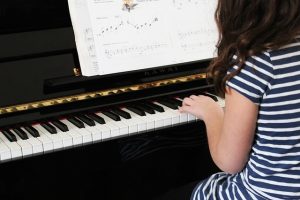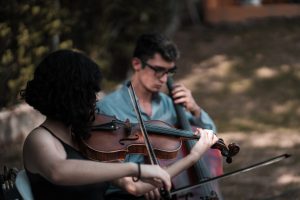Parent Interview: Strategies for supporting practice at home
We sat down with a WAPS team member to discover some of the strategies they used when helping their child practise at home – and how that changed over the years. See if you can read through to the end and guess which of our current WAPS teachers is the child in the article!
It became apparent quite early on that our child enjoyed listening to and then playing music. To encourage her, we began new habits like playing music at home and in the car, attending free concerts, and from the age of three, buying a few musical instruments that we wouldn’t mind being broken. This was all before enrolling our child in early childhood music classes that taught children so much while they were having fun. We did not want to begin formal music lessons until our daughter started primary school and got used to formal lessons and routines. By the time she was 6 she had been waiting patiently for her very first violin for so long that she was in awe of it when I gave it to her at her first violin lesson!
Over the years, practice time was not the easiest part of learning to play music in our house (both for the child and for the parent!) but to make it easier, we used the strategies below:
Early Years..
- We used a practice schedule for existing repertoire (repertoire being the pieces that the child has already finished learning, but must still be practised so they’re not forgotten). The schedule also listed the days of the week written in three languages, as we are a trilingual family. It gave us a clear structure, but listed different pieces on different days to avoid boredom when maintaining repertoire.
- I sat in our ‘music room’ (living room) as the audience for every practice for many years and tried to ‘read the room’ to keep things calm, without being bamboozled into stopping the practice by an unwilling child. I found that having to pop out quickly “to do something” while taking a couple of deep breaths helped most times.
- To keep the practice fresh and to motivate my daughter, we occasionally arranged for pieces to be performed for visitors.
- Family and friends started buying CDs and other music-related gifts that would again help to motivate our daughter and help her look to the future.
- I always sat in on private lessons, and in many group lessons too. Over the years this not only helped me monitor practice at home, but to get to know the parents and teachers. It meant I could easily ask teachers for help and also be sure that our family was compatible with their teaching philosophy and expectations.
- I decided very early on to avoid the temptation to compare my daughter with other children. Each child is different and music education is not a competition. As long as we did what we said we would do and we did not tell tall stories about our practice routines, we were going to be fine and it didn’t matter to us how far we were in the music book or where in the orchestra my daughter would be sitting.
- We chose milestones and celebrated them, involving our daughter in the decision-making process. When she completed a violin book, she was allowed to choose a porcelain doll to add to her collection – they even served as audience members for her while she practised!
Later On..
- When my daughter got older I did not need to sit in at practice time but I was still in the house, within hearing range. I am sure I also used little subterfuges like saying that
- “I really liked that piece and that I would have loved to hear it again”, if the piece actually really needed to be practiced again.
Our teacher used a communication book to give instructions for practice between lessons and during home practice I would have made notes in the book if something needed to be discussed with the teacher at the next class. - We were honest with the teacher when our practice wasn’t working out, and so received many good tips to help when we needed it.
- We were very lucky to have a teacher who volunteered to perform for specific groups (for example the elderly, or sick children in PMH) or to fundraise by busking in the city. Being part of these performance groups was a great motivator to practise ahead of the performances and gave so much satisfaction too.
- As my daughter became older, more opportunities came her way to participate in Christmas carols and other community events, and that was when she could see the results of all the years of learning and practising. It was a perfect example of delayed gratification, and this was probably the biggest pay-off for both of us (apart from her going on to earn a living from her music to this day!).
Looking back, I can definitely say that it was all worth it!
Did you guess which staff member is the child in this article?




























 Studio: 3 Price Street, SUBIACO WA 6008
Studio: 3 Price Street, SUBIACO WA 6008


